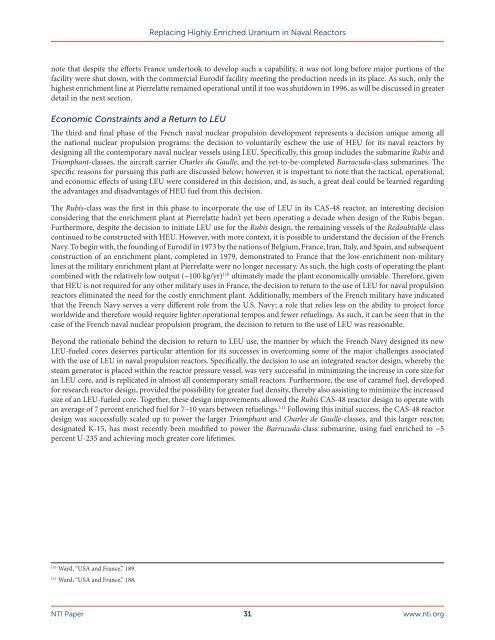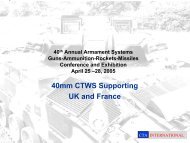Replacing Highly Enriched Uranium in Naval Reactors
Replacing_HEU_in_Naval_Reactors_Report_FINAL
Replacing_HEU_in_Naval_Reactors_Report_FINAL
You also want an ePaper? Increase the reach of your titles
YUMPU automatically turns print PDFs into web optimized ePapers that Google loves.
<strong>Replac<strong>in</strong>g</strong> <strong>Highly</strong> <strong>Enriched</strong> <strong>Uranium</strong> <strong>in</strong> <strong>Naval</strong> <strong>Reactors</strong><br />
note that despite the efforts France undertook to develop such a capability, it was not long before major portions of the<br />
facility were shut down, with the commercial Eurodif facility meet<strong>in</strong>g the production needs <strong>in</strong> its place. As such, only the<br />
highest enrichment l<strong>in</strong>e at Pierrelatte rema<strong>in</strong>ed operational until it too was shutdown <strong>in</strong> 1996, as will be discussed <strong>in</strong> greater<br />
detail <strong>in</strong> the next section.<br />
Economic Constra<strong>in</strong>ts and a Return to LEU<br />
The third and f<strong>in</strong>al phase of the French naval nuclear propulsion development represents a decision unique among all<br />
the national nuclear propulsion programs: the decision to voluntarily eschew the use of HEU for its naval reactors by<br />
design<strong>in</strong>g all the contemporary naval nuclear vessels us<strong>in</strong>g LEU. Specifically, this group <strong>in</strong>cludes the submar<strong>in</strong>e Rubis and<br />
Triomphant-classes, the aircraft carrier Charles du Gaulle, and the yet-to-be-completed Barracuda-class submar<strong>in</strong>es. The<br />
specific reasons for pursu<strong>in</strong>g this path are discussed below; however, it is important to note that the tactical, operational,<br />
and economic effects of us<strong>in</strong>g LEU were considered <strong>in</strong> this decision, and, as such, a great deal could be learned regard<strong>in</strong>g<br />
the advantages and disadvantages of HEU fuel from this decision.<br />
The Rubis-class was the first <strong>in</strong> this phase to <strong>in</strong>corporate the use of LEU <strong>in</strong> its CAS-48 reactor, an <strong>in</strong>terest<strong>in</strong>g decision<br />
consider<strong>in</strong>g that the enrichment plant at Pierrelatte hadn’t yet been operat<strong>in</strong>g a decade when design of the Rubis began.<br />
Furthermore, despite the decision to <strong>in</strong>itiate LEU use for the Rubis design, the rema<strong>in</strong><strong>in</strong>g vessels of the Redoubtable-class<br />
cont<strong>in</strong>ued to be constructed with HEU. However, with more context, it is possible to understand the decision of the French<br />
Navy. To beg<strong>in</strong> with, the found<strong>in</strong>g of Eurodif <strong>in</strong> 1973 by the nations of Belgium, France, Iran, Italy, and Spa<strong>in</strong>, and subsequent<br />
construction of an enrichment plant, completed <strong>in</strong> 1979, demonstrated to France that the low-enrichment non-military<br />
l<strong>in</strong>es at the military enrichment plant at Pierrelatte were no longer necessary. As such, the high costs of operat<strong>in</strong>g the plant<br />
comb<strong>in</strong>ed with the relatively low output (~100 kg/yr) 110 ultimately made the plant economically unviable. Therefore, given<br />
that HEU is not required for any other military uses <strong>in</strong> France, the decision to return to the use of LEU for naval propulsion<br />
reactors elim<strong>in</strong>ated the need for the costly enrichment plant. Additionally, members of the French military have <strong>in</strong>dicated<br />
that the French Navy serves a very different role from the U.S. Navy; a role that relies less on the ability to project force<br />
worldwide and therefore would require lighter operational tempos and fewer refuel<strong>in</strong>gs. As such, it can be seen that <strong>in</strong> the<br />
case of the French naval nuclear propulsion program, the decision to return to the use of LEU was reasonable.<br />
Beyond the rationale beh<strong>in</strong>d the decision to return to LEU use, the manner by which the French Navy designed its new<br />
LEU-fueled cores deserves particular attention for its successes <strong>in</strong> overcom<strong>in</strong>g some of the major challenges associated<br />
with the use of LEU <strong>in</strong> naval propulsion reactors. Specifically, the decision to use an <strong>in</strong>tegrated reactor design, whereby the<br />
steam generator is placed with<strong>in</strong> the reactor pressure vessel, was very successful <strong>in</strong> m<strong>in</strong>imiz<strong>in</strong>g the <strong>in</strong>crease <strong>in</strong> core size for<br />
an LEU core, and is replicated <strong>in</strong> almost all contemporary small reactors. Furthermore, the use of caramel fuel, developed<br />
for research reactor design, provided the possibility for greater fuel density, thereby also assist<strong>in</strong>g to m<strong>in</strong>imize the <strong>in</strong>creased<br />
size of an LEU-fueled core. Together, these design improvements allowed the Rubis CAS-48 reactor design to operate with<br />
an average of 7 percent enriched fuel for 7–10 years between refuel<strong>in</strong>gs. 111 Follow<strong>in</strong>g this <strong>in</strong>itial success, the CAS-48 reactor<br />
design was successfully scaled up to power the larger Triomphant and Charles de Gaulle-classes, and this larger reactor,<br />
designated K-15, has most recently been modified to power the Barracuda-class submar<strong>in</strong>e, us<strong>in</strong>g fuel enriched to ~5<br />
percent U-235 and achiev<strong>in</strong>g much greater core lifetimes.<br />
110<br />
Ward, “USA and France,” 189.<br />
111<br />
Ward, “USA and France,” 188.<br />
NTI Paper 31 www.nti.org



